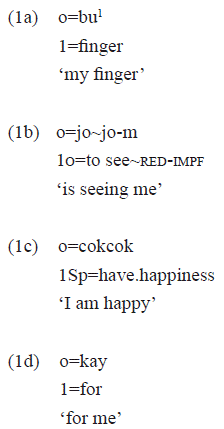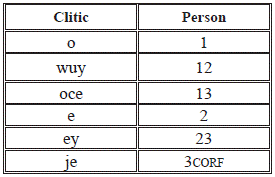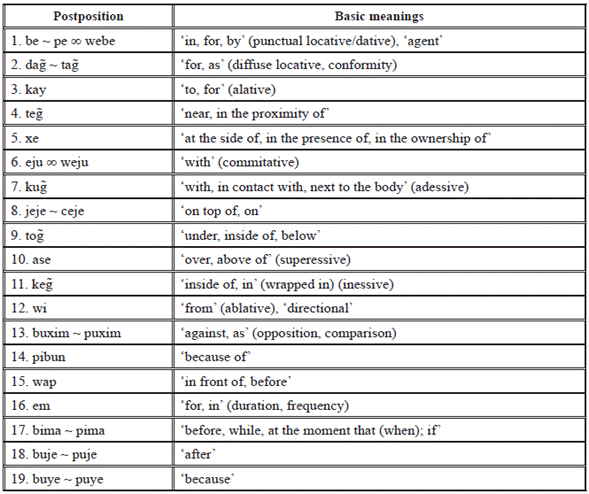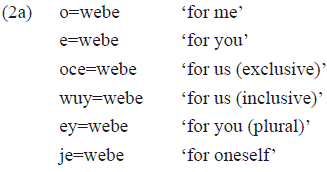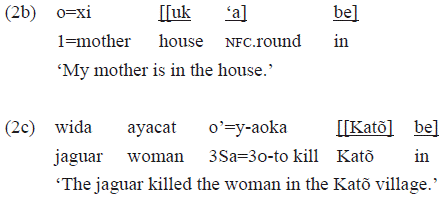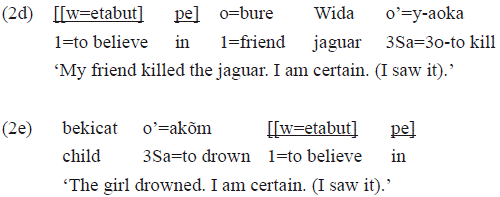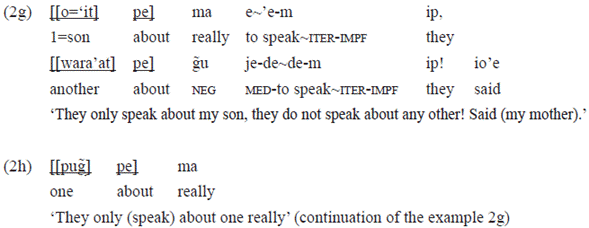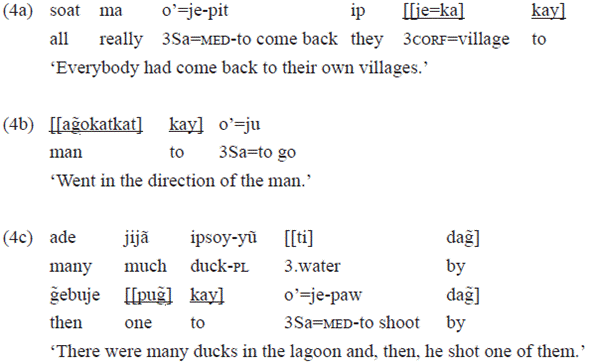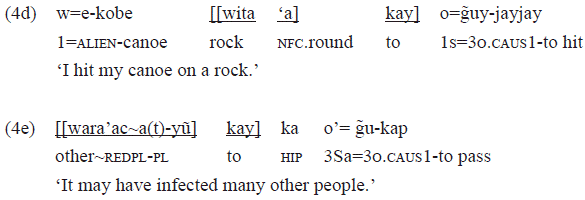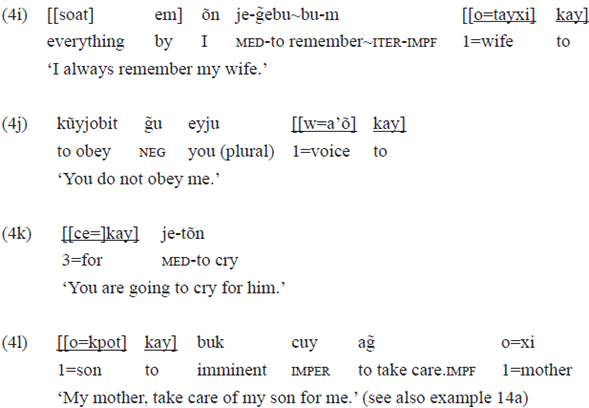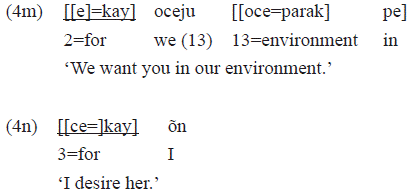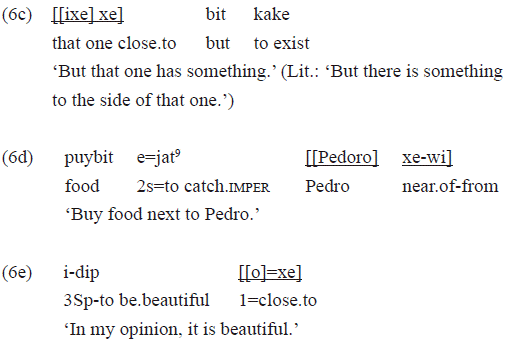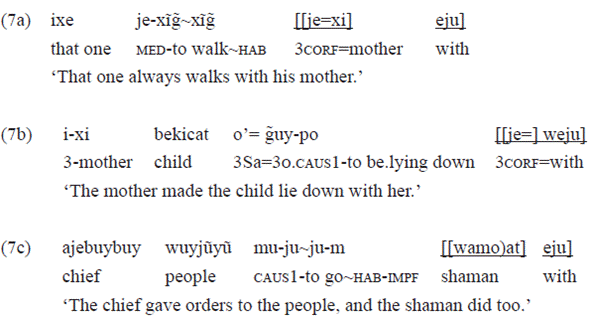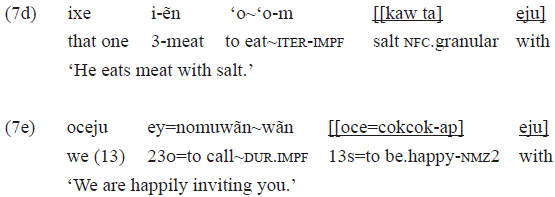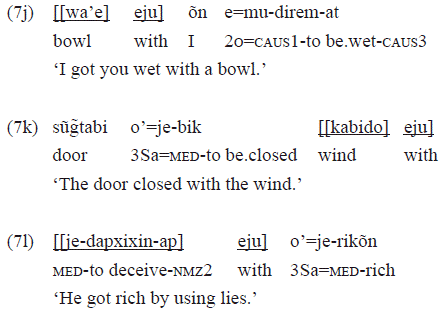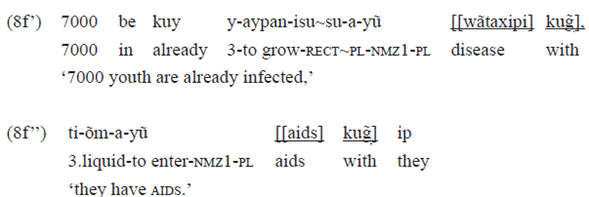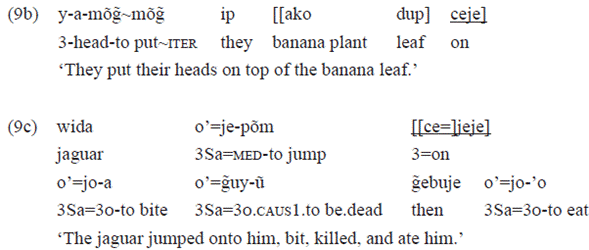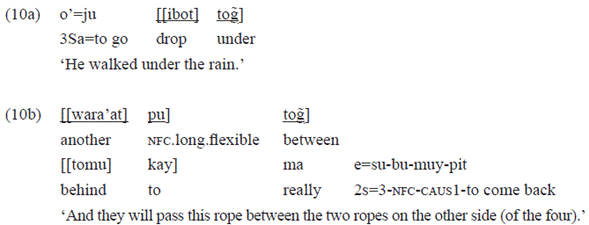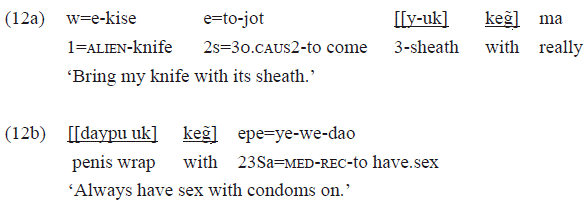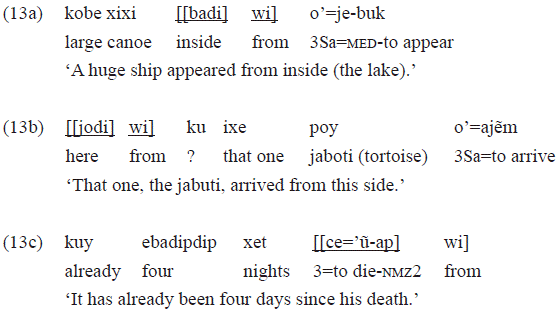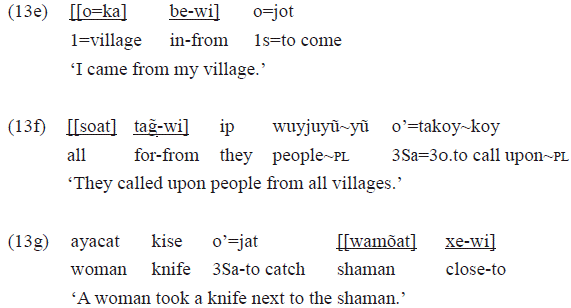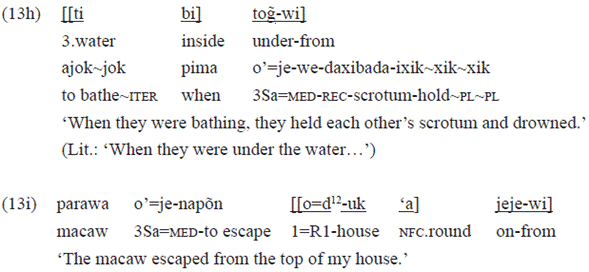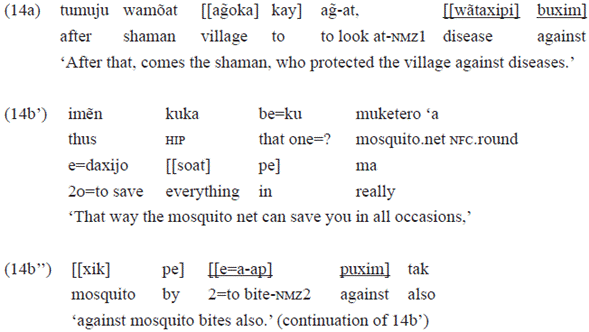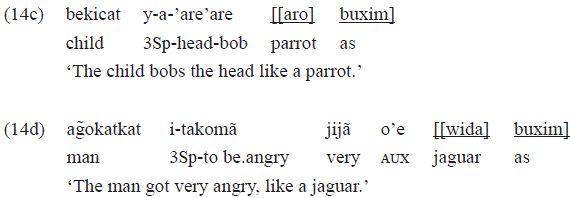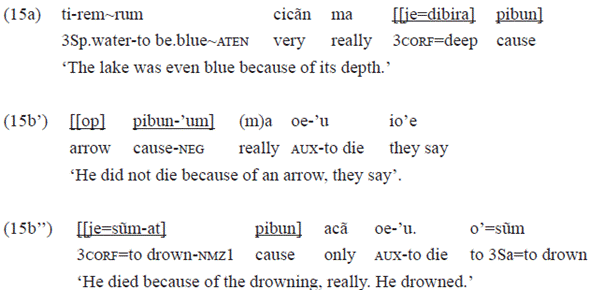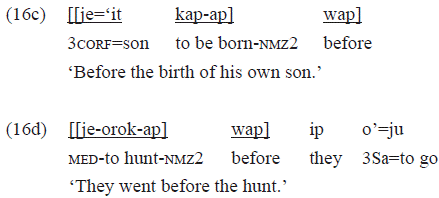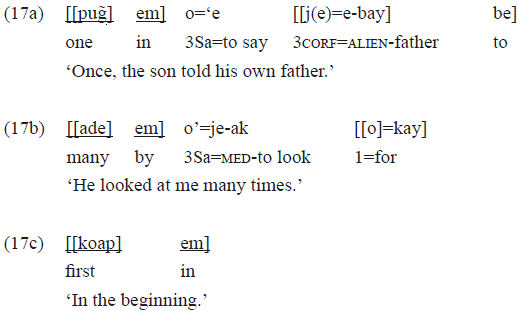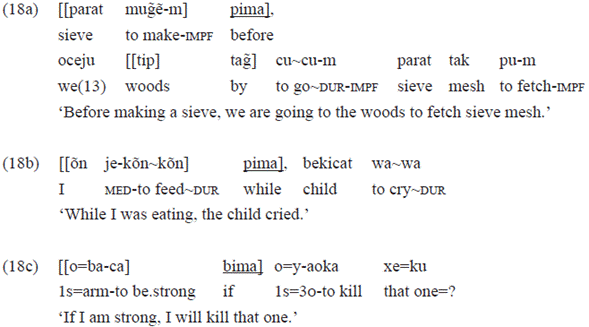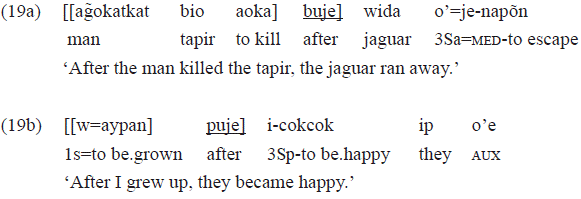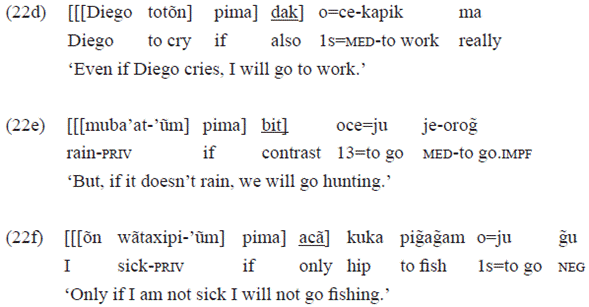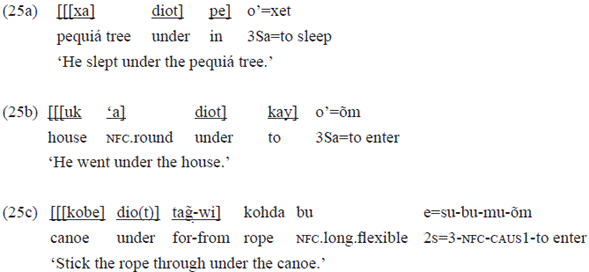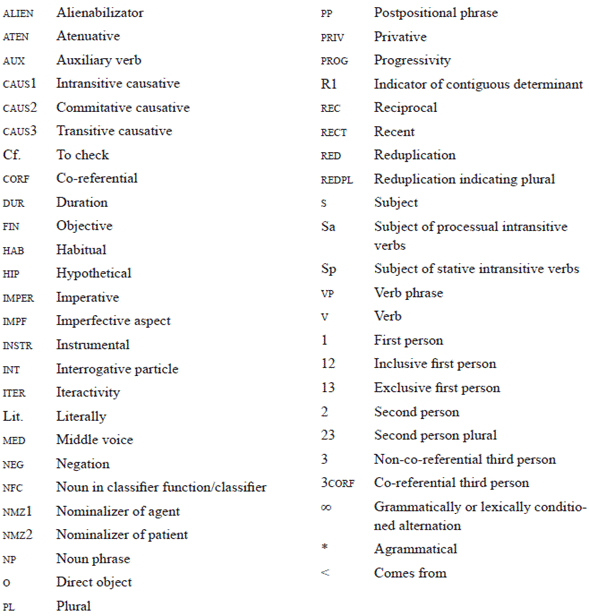1. INTRODUCTION
The Munduruku people, with about 13 thousand people (Siasi/Sesai, 2013), live in the states of Pará and Amazonas, including a handful of residents in Mato Grosso, Brazil. Unfortunately, with rare exceptions, the population of Amazonas do not speak the language any more (Santos, 2013). My research about the language has taken place with the population of Pará, where the Munduruku are found in the low, mid and high Tapajós river and its tributaries (Gomes, 2006). This is a language of the Tupi stock, belonging to the Munduruku family and sister of Kuruaya (already extinct). It is a language of the head-marking type. The most common constituent order is s(O)V. The arguments do not receive morphologic marks, usually occurring in noun phrases. The verb receives person marks, which indicate/co-refer subject and direct object.
Our objective here is to present the inventory of postpositions, in order to discuss the properties they share; what their structural and functional features are; and their participation in the passive voice, causative, subordination, modality, source of information, and locative and possessive predication. We also approach the isomorphism among postpositions, nouns and verbs; the syntactic relation that establishes the postpositional phrase (PP) with the rest of the sentence: whether argument or adjunct. And we will also reflect upon its typology.
Besides this introduction, the text is divided into four sections. In section 2, we present the postpositions; in section 3, we discuss the possibility of their nominalization; in section 4, we approach the relational/inalienable nouns used as postpositions or combined with a postposition; and, in section 5, we make some final considerations, highlighting the typological, functionalist, and cognitivist points.
2. POSTPOSITIONS IN MUNDURUKU
2.0. General Characteristics
Postpositions can introduce semantic relations of locative, time, cause, purpose, beneficiary, agent, instrument, company, comparison, opposition types. They constitute a closed category, occurring as free words and always require a complement. This complement can be nominal or pronominal, as we will demonstrate further. As a rule, a postpositional phrase is an adjunct, although it can also be the nucleus of the predicate or even a possible argument of the verb, at least in the semantic scope, as we will discuss throughout this text.
Postpositions share with nouns and verbs some morphosyntactic properties, such as person marking, which occurs by means of a clitic pronou1:
The example 1a shows the inalienable noun «-bu» 'finger' that obligatorily occurs with the person marker «o=» '1st person', indicating the possessor of the noun2. The paradigm of person marking of which «o=» is part, is also used to indicate the direct object of transitive verbs, such as in the example 1b, the subject of intransitive stative verbs3, as in the example 1c, and the object of postpositions, as in the example 1d.
Thus, postpositions feature a certain isomorphism4 with nouns and verbs, an example of which is the personal clitic marking. In Table 1, we show the personal clitic markers that are used to express: complement of postposition, nominal possessor and absolutive argument of transitive and intransitive stative verbs.
Regarding specifically the expression of non-co-referential third person, postpositions have greater affinity with alienable nouns. Both have the same personal marking: «ce=». While inalienable nouns (and a few postpositions) mark the third person with a prefix (nominal subclass I) or by means of the alternation of the initial consonant of the root of [d]/[n] for [t] (nominal subclass ii), alienable nouns and the majority of the postpositions indicate the third person by the clitic «ce=»:
As already mentioned, there is a group of postpositions that marks the third person by means of the prefix present in inalienable nouns, stative verbs and in transitive object argument. They are: «kug̃» 'with', «buje ~ puje» 'after', «buye ~ puye» 'because', and «bima ~ pima» 'before, during, in the moment that (when), and if'. With the exception of the first one («kug̃»), the others constitute a particular group of postpositions that head phrases in which the object is of clausal nature, constituting a type of subordinator. We will discuss this group in section 2.17.
Continuing with the formal analysis of the postpositions, syntactically speaking, they have an obligatory complement that can be a noun, pronoun, adverb, or even a clause. The postpositional phrase (PP) constituted by them does not have the typical syntactic behavior of verbal arguments. The verbal arguments in Munduruku can be (CO)referenced in the verb in the form of clitics or prefixes. This is not applied to the pp, which is then considered prototypically circumstantial, peripheral constituent, and adjunct. This differentiates the postpositions of nouns that fulfill argument nuclear functions, such as subject and object. Nevertheless, throughout the analyses carried out here, we will return to this subject, attempting to develop it and mainly showing in which contexts this treatment of postpositions as adjunct can be somewhat flexibilized.
Next, we will present a summarized table of the postpositions identified in our research and their respective meanings:
For a more detailed understanding of this category, we present and exemplify each of the postpositions of this table in the most varied contexts that we have had access to in our field work between 1999 and 2017. This will allow for better exploration of the forms and functions of these postpositions, especially their role in linguistic processes of modality, causativity, passive voice, and subordination, besides the roles typically associated with the PP.
2.1. be ~ pe ∞ webe
With lexical complements, this postposition has the form «be» after vowels and «pe» after consonants. With pronominal complements, the form used is «webe»:
With third person clitic «ce=», the used form is «be»: «ce=be» 'for him'. Next, we present the different functions of this postposition.
2.1.1. «be/pe»: punctual locative
The postposition «be/pe» has the basic meaning of 'punctual locative' and indicates a precise location (in this case, it is opposed to the postposition «dag/tag» 'diffuse locative', that we will present in section 2.2).
In the examples throughout this text, we will highlight the internal structure of the pp. In the example 2b, the pp «[[uk' a] be]» 'at the house' has the postposition «be» as head, and the noun phrase (NP) «uk 'a» 'house' is its complement. Pieces of evidence in favor of the identification of postpositional phrases such as these are:
(1) the fact of not being able to invert the complement with the head or to extract the complement without generating a personal marking of 3rd person; (2) the exclusive possibility of displacement of the set «[[uk 'a] be]». The NP complement, in turn, is structured as «[[uk] 'a]», where the noun in classifying function «'a» 'rounded' functions as its head (Gomes, 2006). Besides pp being able to have a NP of complex structure as complement, the Munduruku also has pp with simple np as complement, as in the example 2c: «[[Katõ] be]» 'in the Katõ (village)'.
Regarding syntax, the example 2c illustrates one of the main uses of pp in Munduruku: to be an adverbial nature adjunct. The basic constituent order in this language is subject-object-verb (SOV). In the example 2c, the subject and object arguments are, respectively, «wida» 'jaguar' and «ayacat» 'woman'. Arguments are not marked by case, and the order is the identification factor of these grammatical relations. Besides, the verb «o'=y-aoka» 'it killed her' has two pronominal indexes responsible for identifying these grammatical relations: «o' =» 'third person of processual verb' and «y-» 'third person direct object'. Thus, the lexical (or pronominal) arguments are identified in the verb.
Still, in syntactic terms, the PP «Katõ be» occurs in the final position, a very common position for postpositional phrases, which does not have a morphosyntactic slot in the verb, as the subject and direct object arguments. Usually, PPS do not constitute arguments of transitive or intransitive verbs, as they are not part of its syntactic valency. But, from the semantic point of view, there are contexts in which the pp seems essential. This does not occur in the example 2c, but will occur with the direct agent of causative and passive constructions, i.e., as we will analyze in section 2.1.3.
The example 2b «o=xi [[uk 'a] be]» 'my mother is at the house' allows us to introduce a reflection on the value of locative predicate assumed by the pp «[[uk' a] be]». In that case, the pp cannot be classified as adjunct, remaining as the head of the locative predication. Several other examples such as this will appear throughout this text. We will return to the status of grammatical relations that may or may not have a pp in Munduruku, in section 5. Next, we approach other functions of the postposition «be».
2.1.2. «be»: modality marker
The postposition «be» is also used as a modality marker, which extrapolates the typical adverbial value of locative space or locative predicate as presented in the previous section.
The verb «etabut» 'to believe' is a stative intransitive verb that occurs with a circumstantial led by the postposition «kay», typical of psychological verbs (cf. section 2.3.2). Nevertheless, in the examples 2d and 2e below, «etabut» was used nominally, as complement of the postposition «pe» This pp has a modality function:
In these examples, when using the pp «[[w=etabut] pe]» 'in my knowledge', the speakers insert a high degree of certainty in the information given, since they are the witness that is the source of the occurrence. The preferred order is the pp in the initial position, as in the example 2d, but this is not strictly so, with the pp being able to occur also in its more frequent position, which is the end of sentence, as in the example 2e.
Next, we approach other uses of the PP headed by the postposition «be/pe».
2.1.3. «be/pe»: benefactive, agent offactive causative, agent of the passive, or dative of interest
In this section, we discuss postpositional phrases with «be/pe» that indicate: a) the beneficiary of three-place verbs of the «ũm» 'to give' type; b) the target of verbs of the «'e» 'to speak' type; c) the direct agent of causative transitive verbs; d) the passive voice agent; e) the dative of interest. From the syntactic valence point of view, we continue to interpret these pp as adjuncts and not as arguments, given the justifications presented in section 2.0. Yet, semantically, these pp are foreseen in the verb grid and, the way we see it, they compose their semantic valency. Let us see each one of them.
a) PP «be/pe» as beneficiary of the verb «ũm» 'to give':
The verb «ũm» 'to give' requires, morphosyntatically, two arguments as we can see in the example 2f, namely: a subject («ẽn» 'You') and a direct object («kise» 'knife'). These two arguments keep a grammatical relation with the verb, morphologically, as they are retaken or identified in it by means of pronominal indexes: «e=» 2s and «g̃-» 3o. The beneficiary of the action («ayacat pe» 'for the woman') does not find space in the verbal morphology and occurs in a pp, typically in the final position in the sentence:
The PP is not syntactically required by the verb, but it is essential semantically. This compels us to claim that it is an important participant for the argument grid of the verb, by fulfilling its semantic valency.
b) PP «be/pe» as addressee/target of verbs of the type to speak («'e, jede, jekawẽn»)
In Munduruku, the verbs «'e, jede, jekawën» mean 'to speak'. Their semantic nuances will not be discussed here. All these verbs are intransitive. Next, we show their use in sentences taken from a narrative about a child who appeared to have a physical disability and who, together with his mother, was the target of gossip among the people of the village:
In the example 2g, the verb «'e» 'to speak' occurs, reduplicated and with the suffix of imperfective aspect «-m»5: «e~'e-m». In this case, the subject is not morphologically explicit, typical of this aspect, but it can easily be restored in the discursive context, having been cited in the previous statements. This verb is intransitive and does not require a direct object in the form of a phrase or pronominal index in the verb. The topic of the gossip is expressed in a PP: «[[o='it] pe]» 'about my son'. The same occurs with the verb «je-de~de-m» 'to speak meanly of somebody/engine noise', equally reduplicated, with imperfective and intransitive suffix. The target of this 'to speak' is also a PP: «[[wara'at] pe]» 'about another' and «[[pug̃] pe]» 'about one' (example 2h). This last example includes a numeral pronoun as complement of the postposition. Finally, these addressees or targets of gossip appear in postpositional phrases. This is not required syntactically by the verb, but it is semantically important and indispensable for the construction of the narrative.
c) PP «be/pe» as a direct agent of causativized transitive verbs6
The example 2i' is a prototypical transitive predicate in Munduruku:
In the example 2i', the subject is «puy bu» 'snake' and the object is «bekicat» 'child'. These grammatical relations are confirmed by the constituent order and the cross-reference markers in the verb. If the subject were a second person, «puy bu» 'snake' would be replaced by «ẽn» 'You', and «o'=» 3Sa would be replaced by «e=» 2s. In the example 2i', «puy bu» 'snake' is the agent and «bekicat» 'child' is the patient. In Munduruku, it is possible to introduce a new agent: an indirect agent (the causer). A transitive verb like «a» 'bite' will be followed by the suffix «-at», which is responsible for turning transitive verbs into causative verbs. The direct agent (the causee) is moved to the end of the sentence and it becomes part of a postpositional phrase (Gomes, 2014). The example 2i' ' shows a pp with a semantic role of direct agent where the head is «be»:
In this example, the PP «[[puy bu] be]» 'by the snake' functions, syntactically, as an adjunct, occurring in the final position, not finding space in the morphosyntax of the verb, which is filled only by the subject («o=» 1s) and direct object («jo-» 3o) arguments. However, the pp has the important semantic role of direct agent in the action. In the causatives constructed from transitive verbs, such as the example 2i'', the subject argument is reserved for the indirect agent (the causer), relegating the direct agent (the causee) to the syntactic space of adjunct. The pragmatic-discursive effect of this type of formal expression of the direct and indirect agent requires further explanation.
d) PP «be/pe» as agent of the passive
The example 2j' is a prototypical transitive construction:
In the example 2j', the subject is «wida» 'jaguar' and it is the agent. The object is «ayacat'üm» 'woman' and it is the patient. The constituent order and the cross-reference markers in the verb indicate these grammatical relations. If the subject were a second person, for example, «wida» would be replaced by the pronoun «en» and, in the verb, the cross-reference marker of subject would be «e=», a singular second person clitic. Next, a passive construction is presented in order to contrast it with the active 2j':
The passive voice in Munduruku poses interesting typological challenges (Gomes, 2005, 2014). In short, a transitive verb is made intransitive by the middle voice prefix «je-» and the suffix «-at», which is responsible for turning transitive verbs into causative verbs. The result is an intransitive verb with only one place for a personal marker in the verb. This contrasts with the typical transitive verbs, which have two places for cross-referencing arguments, as in the example 2j'. In 2j'', the patient takes the place of subject argument and the agent behaves like a typical adverbial adjunct. The agent of the example 2j'' is «[[wida] be]» 'by the jaguar' and occurs in the final position of sentence in a PP. This PP is also important from the semantic point of view for bringing up the agent foreseen in the passivized verb, although it is dispensable from the syntactic point of view.
This ambivalence between being syntactically dispensable and semantically relevant marks these postpositional phrases presented in this section. We will return to this topic in section 5.
Let us see another use of the PP «be/pe», the dative of interest.
e) PP «be/pe» as dative of interest
In the example 2k, the pp «[[o=kipit] pe]» 'for my brother' has the semantic role of dative of interest:
In the example 2k, the verb «a'õxik» 'to argue' was intransitivized by the prefixes of middle voice «je-» and reciprocity «we-». The theme or interest of the argument occurs in a PP. Also, we analyze this pp here syntactically as an adjunct, but semantically as an important participant.
In order to express reciprocity, besides the verbal construction «je+we+transitive .verb» as in the example 2k, it can use a postpositional phrase. In that case, the transitivity of the verb is kept, and the reflectivity/reciprocity prefix «we-»7 in the postposition occurs:
2.2. «dag̃ ~ tag̃»
This postposition has the form «dag̃» after a vowel and «tag̃» after a consonant. Next, we present their functions: diffuse locative and conformity.
2.2.1. Diffuse locative
The postposition «dag/tag» mainly expresses the idea of diffuse locative. The example 3a includes a transitive causative comitative verb, where the subject is «õn» 'I' and the object is «kobe» 'canoe'. The pp that occurs there is a locative adjunct: «[[kaxoero] dag̃]» 'by the waterfall'.
In the example 3a, the intransitive verb «kap» 'to pass' was transitivized by the causative prefix «duju-» that is responsible for introducing an argument in the predicate. In this case, the argument was «kobe» 'canoe', with a grammatical relation of object. This causative prefix, particularly, is used with intransitive verbs for building a comitative sense: the object is interpreted as a company of the subject. For more details, see Gomes (2006, 2014).
The example 3b shows an intransitive verb where the subject is «o'=» 3Sa. The pp that occurs there also is an adverbial-nature adjunct, expressing diffuse locative: «[[tip] tag̃]» 'through the woods':
Finally, the example 3c includes a PP with the function of head of a locative predication, also with a diffuse sense also: «[[ce=] dag̃]» 'through him'.
Different from examples 3a and 3b, the PP in 3c has a more central grammatical function, which is semantically important for the construction of the predicate. The example 4c below also uses this postposition with the function of locative predicate.
2.2.2. Conformity: source of the information-postposition «dag̃/tag̃»
Another use of the postposition «dag̃/tag̃» is to indicate 'conformity,' derived from what was displayed previously:
In these examples, the PPS led by «dag̃tag̃» have a nominalized clause as complement. These PP are a way to express the source of the information, and they can exempt the sender from the responsibility of what is being said or done. Its function could even be to introduce an authority voice.
2.3. «kay»
This postposition basically has the function of an alative ('in the direction of'), occurring frequently with verbs that indicate movement, displacement. But it is also the typical postposition of psychological verbs and, in some contexts, it means 'to want', despite the fact that it is not formally a verb.
2.3.1. «kay» as alative
We have identified the alative use of the postposition «kay» with a place (example 4a), person (example 4b) or animal (example 4c) type complement:
In this last example, the complement of «kay» is a numeral pronoun «pug̃», that refers to «ipsoy» 'duck'.
The displacement towards something foreseen in the pp with «kay» can result in physical contact (example 4d) or transmission of something from one body to another (example 4e):
The example 4e was taken from a handbook on infecting communicable diseases and AIDS. The postposition «kay» was chosen to represent the idea of transmission of diseases from one body to another. Now the idea of being infected with the disease is expressed by the postposition «kug̃», which we will discuss in section 2.7.
2.3.2. pp «kay» as adjunct of psychological verbs
The PP headed by «kay» occurs frequently with verbs of psychological nature. In our data, we find intransitive stative verbs, such as «cokcok» 'to be happy' (example 4f), «takõma» 'to be sad' (example 4g), «etabut» 'to believe' (example 4h)) as well as processual intransitive verbs, such as «jeg̃ebu» 'to remember' (example 4i), «küyjobit» 'to obey' (example 4j), «jetõn» 'to cry' (example 4k) and «ak» 'to look at, to take care of (intr.)' (example 4l):
The PP headed by «kay» in the examples 4f, 4g, and 4h followed stative intransitive verbs, and these PPS have as complement, respectively: a noun («aĩhĩ» 'mother'), a free pronoun («ixe» 'him'), and a clitic personal pronoun («o=» 1). These verbs occur frequently without these PPS.
In the examples 4i, 4j, 4k and 4l, we present processual intransitive verbs of psychological nature, followed by pp headed by «kay». Equally, these PPS are of adjunct nature, even though semantically they are more necessary to understand the verb:
In predicates without verbs, the presence of a postpositional phrase with the postposition «kay» as head generates the interpretation of 'to want' (example 4m) or 'to sexually desire' (example 4n). The phrase headed by «kay» is the head of the predication:
In these two examples, once again there is the use of pp with the function of predication head, in this case, a predication that expresses the general idea of 'ownership'.
2.4. «teg̃»
This postposition means 'in the proximity of, close to'. In the example 5a, the transitive verb resulting from a causativization has subject and direct object, both represented in the nucleus of the verbal predication. The PP headed by «teg̃» does not have an argument function, as it is an adjunct, even though the semantics of the verb foresees a place to where the object will be taken:
The example 5b, then, shows the PP headed by «teg̃» in the function of locative predicate:
The example 5c illustrates the use of a clitic personal marker as a complement of the postposition «teg̃», something common among the postpositions in Munduruku:
2.5. «xe»
The basic meaning of the postposition «xe» is 'to the side of' (examples 6a-b):
In the examples 6a-b, the PP headed by «xe» is an adjunct of locative nature. But this postposition has expanded its meaning metaphorically, and has been used also with the value of 'in the ownership of, creation of', as in the examples 6c and 6d, and with the value of 'in the opinion of' (example 6e):9
The example 6e illustrates another use of a PP as modality marker. The statement «idip» '(something/somebody) is beautiful' is modalized by the pp «[[o=] xe]». The literal meaning 'close to me' is used to the derived direction 'in my opinion', to express a subjective evaluation of what is being stated.
2.6. «eju» ∞ «weju»
The postposition «eju» is also presented in the form «weju», that occurs with pronoun complements (see example 7b).
The basic function of this postposition is to indicate 'company' (comitative) with movement or non-movement verbs:
The postposition «eju» occurs with inanimate (example 7d) and abstract (example 7e) elements:
In the example 7e, the pp states an evaluation of the state of spirit of the one making the invitation. This is another example of a modal use of a PP.
In the example 7f, the postpositional phrase headed by «eju» assumes the value of 'to have permission to':
The postposition «eju» frequently occurs with the verb «jeum» 'to go up' (example 7g'):
The example 7g' has a verb that requires only one morpheme, «o=», which indicates the subject argument. But another participant always occurs in the predicate. This participant is always a postpositional phrase. This pp is not an object because, for example, it can not undergo a passive voice change like an object does. Besides this, the adverbial root, in this case «u» 'on the top', that forms the intransitive verb could be combined with a causative prefix «muy-», which occurs with intransitive verbs, nouns, and adverbs (Gomes, 2006), and the result is a transitive verb:
So, the contrast between examples 7g' and 7g'' is evidence of the fact that the verb in the example 7g' is intransitive. However, the fact that a pp always occurs with this intransitive verb suggests that, in this case, the intransitive predicate is bivalent, «[...] understood as predicates which exhibit the syntactic behavior of intransitive verbs, [...] but which are semantically bivalent» (Zariquiey, 2017, p. 725).
Zariquiey (2017) called this kind of object «oblique object», in his analysis of Kakataibo. He proposes three types of objects: objects, quasi-objects, and oblique objects. About oblique objects, he said: «A set of intransitive emotion predicates is systematically used as bivalent intransitive predicates, taking a second argument marked by the indirect locative marker "=mi"» (Zariquiey, 2017, p. 734). Besides the locative marker, oblique objects differ from prototype objects in Kakataibo because: «The use of object switch-reference and object agreement markers in association with oblique objects marked with "=mi" is ungrammatical» (Zariquiey, 2017, p. 735). But they are treated like a less prototype object because «[...] the oblique objects can be targeted by reciprocals and reflexives» (Zariquiey, 2017, p. 735).
However, we do not have formal evidence yet to confirm this hypothesis in Munduruku. We know that the pp participant is obligatory in the predicate with the intransitive verb formed by the «u» 'on the top'. A similar case occurs with the intransitive verb «taybit» 'to know, to be acquainted', which always demands a non-subject participant that occurs with an instrumental suffix (see example 20c).
Yet, this non-subject participant could be an indirect object of intransitive verbs, as claimed by Givón (2001, p. 136): «verbs in this group take a subject and an indirect object, with the latter most commonly marked by an adposition». This discussion is very complex and we can not develop it here. Now, we return to the pp uses of the postposition «eju».
Used with verbs such as «jekawën» 'to speak', «eju» has value of reciprocity, with the verb changing the meaning to 'to talk, to dialogue' (example 7h):
The difference between the postpositions «eju» and «be» in (example 7h), that occur with the same verb, is the idea of reciprocity explicitly present in the first one, with the initiative arising from one of the participants, in this case, the subject. When the initiator of the process is not declared, the reciprocal form «jeweweju» is used:
There is also the use of «eju» with the value of 'instrument/means'10 (examples 7j-l):
2.7. «kug̃»
The postposition «kug̃» occurs with the prefix of third non-co-referential person which differs from the other postpositions, that occur with «ce=». The basic meaning of «kug̃» is 'in contact with':
In the example 8a, the PP «[i-kug̃]» 'in him' provides the information that the sand fleas were in contact with the person's body. In this same sentence, right after the use of «kug̃», two other locative postpositions were used: «be» 'punctual locative' («[[jei] be] » 'in the foot') and «tag̃» 'diffuse locative' («[[soat] tag̃]» 'everywhere', «[[ijebit] tag̃]» 'in his whole body'). Let us see another example with «kug̃» :
The example 8b deals with a young child who was in contact with the mother; therefore, the postposition «kug̃» was used. In this example, the PP headed by this postposition plays the role of locative predicate, as it is not only an adjunct, thus differing from its less argument status in the example 8c, where it has an adjunct function, modifying the processual intransitive verb «ju» 'to go':
This sequence of PP headed by «kug̃» in the example 8c shows one of its more frequent uses: to indicate that something is being carried next to the body. This use ended up generating the interpretation of 'ownership' (such as in the example 8d where the PP plays the role of head of the possessive predicate) or 'in the control of', as in the example 8e:
In the example 8e, the PP «[[aviãw] kug̃]» 'by airplane' leads to the interpretation that the person arrived piloting/controlling the airplane. Should another postposition be used, such as «dag̃» for example, the meaning would be different: as a passenger.
In a handbook on sexually transmissible diseases and AIDS11, the postposition «kug̃» is the one that appears with the meaning of 'to be infected with':
In the examples 8f' and 8f'', the pp headed by «kug̃» has a noun as complement. In the first occurrence, the noun «wãtaxipi» 'disease', in the second occurrence, the noun «aids» 'aids', borrowed from Portuguese. In both sentences, the PP plays the role of possessive predicate, without intercourse.
In the example 8g below, the PP «i-kug̃» also composes the predicate, but follows the verb «ẽm» 'to be'. In the PP, the complement is a prefix of 3rd person, referring to a noun already cited:
2.8. «jeje» ~ «ceje»
This postposition is presented in the forms «jeje» after vowels, and «ceje» after consonants. Its meaning is 'on, on top of':
In the example 9a, the pp headed by «jeje» constitutes a locative predicate. In the examples 9b and 9c, it functions as an adverbial adjunct, modifying a transitive verb in 9b («y-a-mõg̃~mõg̃» 'to place') and a processual intransitive verb in 9c («o'=je-põm» 'to jump').
2.9. «tog̃»
The postposition «tog» means 'under' (example 10a) or 'between' (example 10b):
In the example 10c, the postposition «tog̃» is combined with the postposition «wi» used there with a directional value:
The combination of the postposition «wi», of directional value, with other postpositions will be discussed in section 2.12. The use of the postposition «pima» will also be discussed below, in section 2.17.1.
2.10. «ase»
The meaning of this postposition is 'over, above'. In the example 11a, we present its use in pp with temporal-locative predicate function. The physical position of the sun centered above people generates the temporal interpretation that it is the middle of the day:
The example 11b shows an adverbial use of the pp headed by «ase»:
2.11. «keg̃»
The postposition «keg» has the notion of 'package', as shown in the examples 12a and 12b:
The example 12a illustrates the most common use of the postposition «keg», associated with casings of instruments such as knife sheaths. In turn, the example 12b shows a derived use, where «keg̃» was chosen to appear as guidance regarding the use of male prophylactics, also categorized as wrappings: «[[daypu uk] keg̃]» 'with condoms on'.
2.12. «wi»
This postposition means 'from', with value of 'origin':
Particularly, the example 13c shows the use of «wi» as head of a PP, where the complement is a nominalized verb. Besides, the meaning is temporal and not spatial, as in the other examples.
2.12.1. «wi» + other postpositions
The postposition «wi», indicating direction, can be combined with other postpositions, such as «be» 'in' (example 13e), «tag̃» 'for' (example 13f), «xe» 'near' (example 13g), «tog̃» 'under' (example 13h) and «jeje» 'on' (example 13i):
This combination of diverse postpositions with «wi», as may be inferred from the examples, is quite productive. The semantic value of origin in «wi» is responsible for this range of combinations.12
2.13. «buxim» ~ «puxim»
This postposition takes the form «buxim» after a vowel and «puxim» after a consonant. Its meaning is of 'opposition' (examples 14a and 14b'') or 'comparison' (examples 14c and 14d):
These two functions: opposition (examples 14a and 14b'') and comparison (examples 14c-d) for the same postposition raise a significant challenge in typological, functional, and cognitive terms.
2.15. «wap»
The postposition «wap» means 'in front of' (examples 16a-b) and 'before' (examples 16c-d), respectively spatial and temporal use:
The example 16a includes an NP made up of two nouns as a complement of the postposition «wap», while the example 16b shows a clitic pronoun of non-co-referential third person («ce=»). Neither of the PPS is required by the argument grid of the verb.
The examples 16c and 16d, below, have a nominalized verb as head of the complement of the pp headed by «wap», that takes on a temporal value there:
2.16. «em»
This postposition has a temporal value. In the example 17a, the numeral quantifier pro -noun «pug» 'one' occurs as a complement of the postposition; in the example 17b, the indefinite quantifier pronoun «ade» 'many' occurs; in the example 17c, it is the adverb «koap» 'first' that functions as its complement13:
This temporal use of «em» is quite frequent in Munduruku, and its most common position is at the beginning of the sentence. We still find the use of this postposition with the meaning of place, combined with the indefinite quantifying pronoun «soat» 'everything, all', creating the meaning of 'in many places':
2.17. Postpositions used also as subordinators
In this section, we present a set of postpositions that frequently behave as subordinators, having a clause as complement. They are: «bima/pima», «buje/puje» and «buye/puye».
2.17.1. «bima» ~ «pima»
Of mainly temporal nature, this postposition takes the value of 'before' (example 18a), 'while' (example 18b), or 'condition' (example 18c), depending on the context. Its complement is frequently of phrasal nature, evidencing a subordinator use:
This conditional value taken on by the postposition «bima» in 18c is an example of the fact that in languages there is a tendency to use temporal markers with conditional value, expressing (inter)subjectivization and, mainly, pragmatic inference (invited inference) as Geis & Zwicky (1971) and Traugott & Dasher (2002) argue.
Although the very use of «bima» is quite frequent with clauses, such as in the examples 18a-c, we also find nouns as complements of pp headed by it. In the example 18d, this postposition has been used as such, in the sense of 'at the moment that (when)':
2.17.2. «buje» ~ «puje»
Also with temporal value, «buje/puje» indicates that an action has happened after another. This postposition frequently has a clause as a complement, functioning as a subordinator:
In the example 19a, the clause that functions as a complement of the postposition «buje» has neither a personal or a subject marker, nor one of object in the transitive verb «aoka» 'to kill'. These markers were expected, as they are typical of the perfective aspect, especially the subject marker. Therefore, there is an indication of less finitude in this clause, which is a complement of «buje», probably revealing the most nominal character of the clause.
The subordinating postposition «buje/puje» in the example 19b also expresses an (inter)subjective and pragmatically inferential value, as identified in relation to the subordinating postposition «bima». Yet, instead of condition, the value of 'cause' is added, which is something also widely identified in literature since Geis & Zwicky (1971) and updated in Traugott & Dasher (2002).
2.17.3. «buye» ~ «puye»
This postposition has the value of cause. In the example 20a, we see its use with a pronominal complement («ibo» 'this'); in the example 20b, the complement is a personal clitic («o=» '1st person'):
However, the most frequent use of the postposition «buye/puye» occurs with phrasal complements, as in the examples 20c and 20d:
In the example 20c, the postposition «buye» takes a very evident subordinator value, since its complement is a clause that still preserves its verbal features (clitic markers of subject and direct object, respectively «o=» '1st person subject' and «jo-» '3rd person object'.
2.17.4. The postpositions «bima, buje, buye» + third person prefix
The last three postpositions presented previously inflect with the 3rd person prefix «i-»: «ibima, ibuje, ibuye». This occurs when the clauses correlated by them are not in the same sentence, and the postposition is not in the same clause it refers to:
Comparing these examples, we can notice that an absolutive pronoun in 21a is used («ey=») and a nominative pronoun in 21b («epe=») to express the same person of the discourse with the same verb («'at» 'cair'). The latter pronoun is the actual form with the processual verb in question, while the former is also the pronoun of (1) nominal possession, (2) direct object, and (3) subject of stative verb. Then, it is possible to assume that the example 21a presents a certain degree of nominalization, caused by the subordination of the clause to the postposition «pima». The absence of this subordination, as seen in the example 21b, does not cause any degree of nominalization to the clause. In the example 21b, «pima» functions more like a postposition, being inflected for the 3rd person with which retakes anaphorically what was said. It is important to highlight that the personal prefix usually refers to an absolutive argument.
In the example 21b, the intonation contour shows a pause between the first and second clauses, proving they are not in the same sentence. For that reason, the postpositional use of «pima» occurs there. This pause is not identified in the example 21a, where the more subordinating use of «pima» prevails.
Another typical characteristic of clauses conducted by one of the postpositions analyzed here is the regular absence of clitic person markers in the verb, possibly due to the less verbal nature of these phrasal complements.
This would explain the non-grammaticality of clauses such as that of the example 22a below, where we find the use of a person marker in a clause conducted by the postposition «puje» («o'takat»), when compared to the grammaticality of clauses such as the example 22b, where the personal marker in the verb does not occur («dakat»):
The example 22c below is also grammatical. In that case, the use of the person marker in the verb of the first clause («o'=takat») was only possible because the postposition was in the second clause. The postposition inflects for the 3rd person prefix («i-buje»), as already explained:
2.17.5. Subordinating postpositions and particles
The examples below show that [[clause]+subordinating postposition] form a set that can be modifiable by a particle in the following shapes:
< < < clause > postposition > particle >
The notions of 'inclusion' «dak» (example 22d), 'contrast' «bit» (example 22e) and 'restriction' «acã» (example 22f) are some of the several functions associated to particles in Munduruku, a category we described in Gomes (2006, section 4.4).
The linguistic change in grammatical status of these postpositions for subordinators discussed in this text deserve further in-depth analysis in future texts.
3. NOMINALIZATION OF POSTPOSITIONS
Postpositions can be nominalized to function as a verb argument (example 23a):
In 23a, the postposition «puje» has received the nominalizing suffix «-at» and started to function as noun phrase head that requires a complement, in the case «kat» 'afternoon'. Thus, the nominalized postposition started to perform the grammatical relation of subject (head) of the transitive-causative verb «mudirem» 'to get wet'14.
Another possible grammatical relation for nominalized postpositions is to be a nominal predicate in an equative predication, as in the example 23b below:
In the example 23b, the postposition «bima» receives the nominalizing suffix «-at», that is reduplicated to indicate plurality: «-ac~at». In this type of use context, the formed Np functions as equative nominal predicate with the purpose of expressing a characteristic of the subject. It is interesting to highlight that to be used as head of locative and possessive predications, the postpositions do not need to be nominalized.
4. RELATIONAL/INALIENABLE NOUNS USED AS POSTPOSITION OR COMBINED WITH A POSTPOSITION…
We have found in our data the use of the inalienable noun «bi» 'inside, mouth' as if it were a postposition:
The noun «bi» refers to a body part: the mouth. And it is also used with the value of 'internal part of'. But its use in the example 24a creates a circumstantial value of modality nature, typical of postpositions, as we saw throughout this text.
The example 10c, renumbered below as 24b, shows the use of «bi» with only the value of noun, functioning with a complement of the postposition «tag̃» :
Some inalienable nouns can form a postpositive locution with postpositions. An example of that is the noun «diot» 'under' that appears below, forming a locution with the postpositions «pe» 'in' «kay» 'for' and «tag̃-wi» 'for-from':
The combination of relational nouns with adpositional elements is also found in other languages, as shown by Levy (2008) in his studies on Totonaco (Mexico). This is another typological feature that can be explored in Munduruku in the future.
5. FINAL CONSIDERATIONS: TYPOLOGICAL, FUNCTIONAL, AND COGNITIVE FEATURES OF THE POSTPOSITIONS IN MUNDURUKU
In this section, we discuss the importance of the postpositions in Munduruku for typological, functionalist and cognitivist studies.
First of all, we highlight that the postpositions can have complements such as nouns (cf. examples 2b-c, 4f, 4i, etc.), pronouns (example 4g), clitic pronouns (examples 4h, 4k, 4m, 4n, etc.), indefinite pronouns (examples 17b, 17d), adverbs (example 17c), and even clauses (examples 18a-c, 19a-b, 20c-d, 21a, 22b, 22d). Besides, the postpositions keep a certain isomorphism with verbs and nouns, a quite relevant fact in the understanding of these categories in Amazonian indigenous languages (Gomes, 2016; Queixalós & Gomes, 2016).
As already identified in typological literature, there are certain adpositions that are multi-functional, performing certain syntactic and pragmatic functions (Epps, 2008; Hagège, 2010). The postposition «be» of Munduruku is a good example of this type, indicating locative (examples 2b-c), dative in trivalent verbs (example 2f), dative of interest (example 2k), addressee/target (examples 2g-h), passive agent (example 2j''), direct agent of factitive causatives (example 2i''), and even epistemic modalizer (examples 2d-e).
On the other hand, Munduruku uses distinct postpositions to express place, target, and source, framing itself in the most common standard out of the five identified in the Pantcheva (2010) typology in this regard. As presented, «be» 'punctual locative' (examples 2b-c) ≠ «kay» 'target' (examples 4a-e) ≠ «wi» 'source' (examples 13a-i).
The postpositional phrases in this language also allow us to collaborate in the controversial discussion on arguments versus adjuncts. Usually, PPS are treated as adjuncts, but as demonstrated by Haspelmath (2003) and Hagège (2010), they can also be arguments. In our discussion, we describe the syntactic value of adjunct of the PP in Munduruku and justify it with criteria that apply to this language (cf. section 2.0, 2.1.1), without claiming that they are universally applicable, which seems to be impossible as disputed by Haspelmath (2014). However, we also show the semantic value of many PPS (cf. examples 2g-h and discussion) and defend the importance of semantic valency, especially in the construction of the passive voice and the causative (cf. examples 2i-j and discussion). We also highlight the vast use of pp as locative predicate (see examples 2b, 3c, 4c, 5b, 8b, 9a, 11a and discussion) and possessive predicate (examples 4m, 4n, 8d, 8f', 8f''). Thus, we do not propose a strict classification of the postpositions acting as adjuncts or arguments, and we think about prototypical terms in this regard, more lined up with analyses such as those by Creissels (2014), Witzlack-Makarevich & Bickel (2013), and Haspelmath (2003, 2014).
We have analyzed some intransitive verbs of the Munduruku according to Givón (2001), for whom a language can have intransitive verbs that present, besides subjects, complements marked by an adposition. This would be the case of the processual intransitive verb «jeum» 'to go up' that occurs with a PP headed by the postposition «eju» (see example 7g').
We still cannot state the same for the psychological verbs that take the pp headed by «kay», but there are strong indications that these verbs require, at least semantically, this type of PP (cf. examples 4f-l). We also defend a possible argument status of PPS with a semantic role of (1) addressee/target or matter of verbs of the type to speak («'e, jede, jekawën») (cf. examples 2g-h), (2) dative of interest (cf. examples 2k-l) and (3) passive agent (example 2j''). We don't yet have formal evidences to confirm that these pps are arguments, like oblique objects in Kakataibo (Zariquiey, 2017).
The pragmatic-discursive use of the postpositions in Munduruku is also remarkable. As we have seen, there are postpositional phrases that took the function of expressing: modality (cf. examples 2d, 2e, 6e, 7e, 24a), source of information, or an authority voice (cf. examples 3d, 3e, 7f).
The conditional value taken on by the temporal postposition «bima» 'when' (cf. example 18c and discussions) and the causal value taken on by the also temporal postposition «buje» 'after' (cf. example 19b and discussion) are examples of pragmatic inference (invited inference) according to Geis & Zwicky (1971) and Traugott & Dasher (2002), for whom these ambiguous uses are at the base of grammaticalization and (inter)subjectivization processes. These postpositions also allow us to highlight their grammaticalization in another perspective: their use as subordinators (cf. section 2.17). Ultimately, this topic and the other topics highlighted here in these final considerations may and should be a matter of future research.













